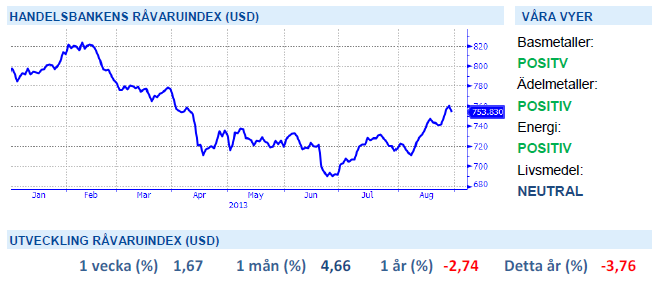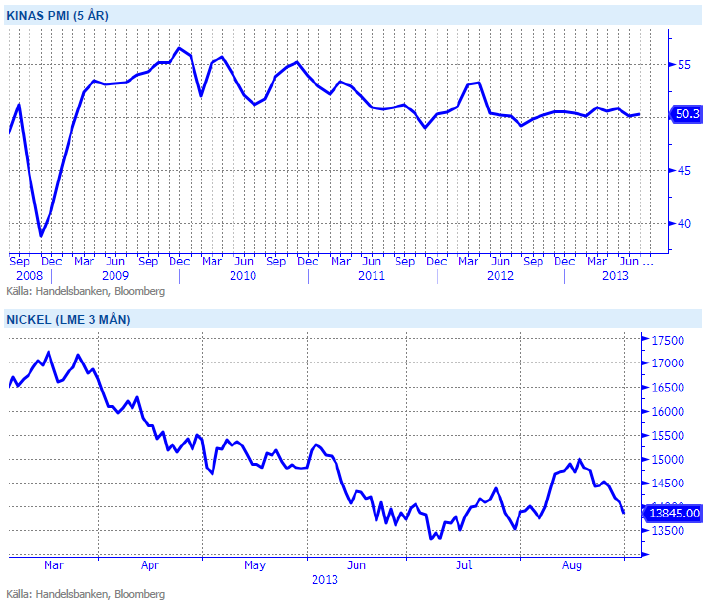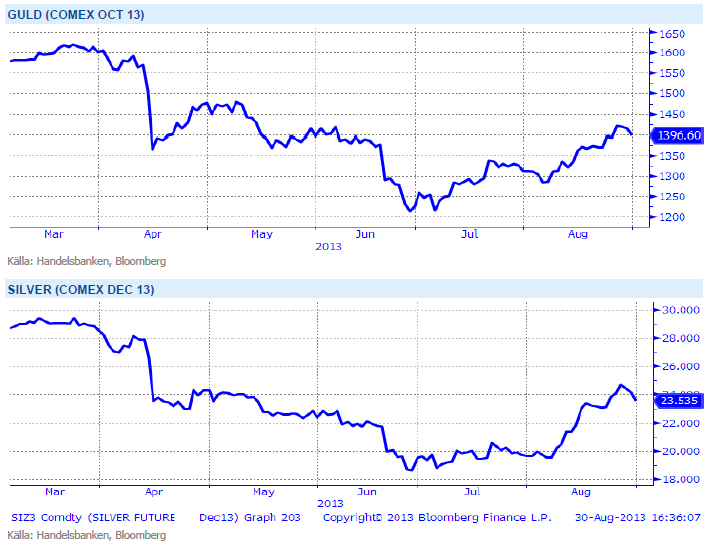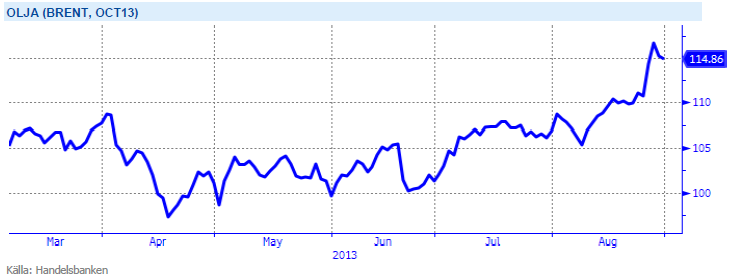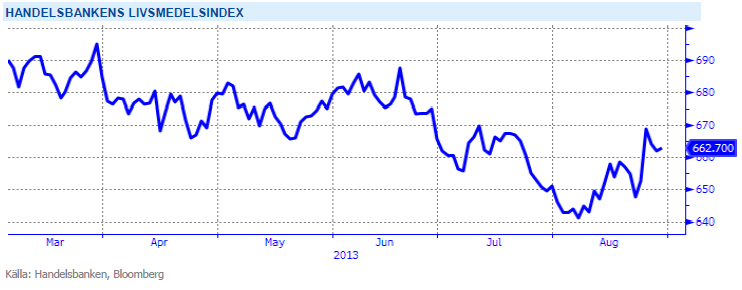Analys
SHB Råvarubrevet 30 augusti 2013

 Råvaror allmänt
Råvaror allmänt
Allt fokus på Syrien
USA tillsammans med Storbritannien och Frankrike laddar upp för någon slags militär intervention i syfte att straffa den syriska regimen för påstådda krigsförbrytelser, kanske i syfte att skicka en signal till andra länder att kemisk krigföring inte är acceptabelt. Detta har gett olja och guldpriset rejäl skjuts och bidragit till ökad volatilitet och sänkt riskaptit generellt på finansmarknaderna. Än så länge är det dock för tidigt att tala om några större negativa ekonomiska effekter från vad som hänt. Vad som händer framöver avgörs av vilka insatser som görs samt vilken respons det får, inte bara från Syriens regering utan även i omkringliggande länder och på ”den arabiska gatan”. Iraks oljeproduktion är den största riskfaktorn just nu. Den Sunni vs Shiite konflikt som råder i Syrien är direkt översättningsbar till Irak. Riskpremien i olja är därför motiverad då Irak, till skillnad från Syrien har en betydande oljeproduktion som Saudi inte kan täcka upp för.
Vårt positiva konjunkturscenario har getts stöd av den senaste statistiken, trots att amerikansk bostadsmarknadsdata på sistone överraskat något negativt. Risken för vissa ekonomiska bakslag senare i höst får sägas vara stigande givet att turbulensen i emerging markets i dagens marknad inte på något sätt tänks påverka varken Europa eller USA.
Basmetaller
I väntan på PMI från Kina
Basmetallerna har fallit något under veckan på den generella risk off rörelsen i bakvattnet av krigsrisken i Mellanöstern och som får industriella råvaror att backa medans klassiska krisindikator som guld och olja stiger. Vårt basmetallindex faller med 1,3 % där nickel återigen tar den största smällen, ner 4 %. Handelsdata, råvaruimport och flash PMI pekar all i rätt riktning för att Kinas makrodata ska kunna bli en otippad positiv överraskning under september.
På söndag publiceras Kinas PMI (det statliga) för augusti där förväntat 50,2 mot 50,3 i juli. HSBC:s PMI publiceras därefter på måndag där förväntat ligger på 50,2 mot 47,7 i juli. Vi räknar med positiv överraskning för dessa båda data vilket kommer driva basmetaller uppåt. Vi behåller vår positiva vy för basmetaller.
Nickel är den basmetall som gått ner mest under året och med många gruvor som går med förlust på dagens prisnivåer tror vi på stigande priser. Vi tror på: LONG NICKEL H
Ädelmetaller
Guld, fortsatt starkt, men platina ännu starkare
Guldet ligger i skrivande stund på samma nivå som förra veckan, 1395 dollar per uns. Förra veckan var det dock veckohögsta, denna veckan är det veckolägsta. Vi har varit uppe på 1430 dollar, drivet av John Kerrys uppskruvade retorik mot Syrien, men inga fundamentala nyheter har påverkat priset denna veckan. Vi tycker fortfarande att prisutvecklingen ser konstruktiv ut, och ligger kvar i vår positiva syn på guldet. Vi har haft 1450 som target i denna prisrörelse, och når vi dit så får vi ta en funderare på nästa steg.
I väntan på detta vill vi slå ett slag för en annan ädelmetall – platina – som inte bara får avsevärt mindre uppmärksamhet än guldet, utan också är något ”smartare” i betydelsen att den har en industriell nytta. Platina har faktiskt utpresterat guldet inte bara under guldets fall under våren, utan även under återhämtningen sedan halvårsskiftet. Vi har en positiv syn på hela ädelmetallsektorn, mest drivet av guldet, men kommer att titta lite närmare på platina framöver. Watch this space!
I ett läge där råvaror generellt har viktats ned av institutionella placerare kan guld och silver få en ”omotiverad” uppgång när dessa indexköpare återvänder till råvaror drivit av bättre utsikter för Kina och USA. Vi tror på: LONG GULD H och LONG SILVER H
Energi
Syrien pressar upp oljepriset
Brentoljan handlades upp på högsta nivån (USD 116.61) sedan februari efter oro kring ytterligare utbudsstörningar i Mellanöstern om västvärlden skulle intervenera i Syrien. Detta utöver rådande MENA oro och produktionsbortfall om ca 2.8 miljoner fat per dag under augusti främst från Iran och Libyen men även från Syrien, Sudan och Irak. Trenden förstärks ytterligare av globala tillväxtförväntningar. Ett ökat intresse för olja som aktiehedge skapar också momentum där marknaden blivit betydligt längre. Saudiarabien producerar närmare 10.5 miljoner fat per dag, den högsta nivån någonsin, vilket resulterar i en global reservkapacitet om endast 1.3 miljoner fat per dag vs USA:s skifferproduktion om 2.5 miljoner fat per dag. De globala utbudsstörningarna har ökat 3 miljoner fat per dag sedan december 2009 att jämföra med tillväxten i USA:s skifferproduktion om 2 miljoner fat per dag under samma period. Med kraftiga utbudsstörningar och låg reservkapacitet kan oljepriset med andra ord skjuta ordentligt i höjden vid en eventuell intervention i Syrien. Oavsett om det sker eller inte räknar vi med ett fortsatt högt oljepris med klar potential på uppsidan. Mer om utvecklingen på oljemarknaden.
Elmarknaden och kvartalet Q413 backar med strax över en procent efter att väderprognoserna tappat den torra avslutning som låg mot slutet av förra veckan. Nederbörden ser ut att gå mer mot normala nivåer vilket skulle innebära ett underskott kring ca 8-9 TWh efter vecka 36. Då gas får stöd av oljemarknaden samtidigt som utsläppsrätterna och kolet handlar oförändrat. Även om kolsentimentet försvagats något ytterligare i fronten, förväntar vi oss att elmarknaden handlar kvar i den range vi fastnat i med risken på uppsidan om vädret slår om mot det torrare slaget igen.
Oroligheterna i mellanöstern med risk för ytterligare produktionsbortfall ger stöd till oljepriset. Vi tror på: LONG OLJA
Livsmedel
Vädret i fokus
Vädret fortsätter att styra prisutvecklingen för vete, majs och sojabönor. Vete och majs steg i början av veckan men efter att regn (dock inga stora mängder) fallit över viktiga regioner i USA handlas grödorna nu på samma nivåer som måndagens öppning. Priset på sojabönor har rört sig sidledes under veckan och stänger något lägre (-1,4 %). Vi fortsätter att hålla neutral vy för denna sektor och konstaterar att väderprognoserna kommer stå i fokus ett tag framöver.
Det är fortfarande torrt vid Elfenbenskusten varför priset på kakao gått sidledes de senaste tre veckorna. Det var i början av augusti som priset på kakao steg 7 procent efter uteblivet regn. Västafrika står för 70 procent av den globala kakaoproduktionen och risken på uppsidan ökar i takt med fortsatt torka i dessa regioner. Kaffepriset fortsätter att backa och i skrivande stund handlas decemberkontraktet på 1,17 dollar/Ib. Årets skörd har hittills inte visat på några större överraskningar och det rapporteras om goda lager. Fler och fler odlare håller på sitt kaffe som följd av de låga kaffepriserna och hoppas på stigande priser.
Handelsbankens Råvaruindex
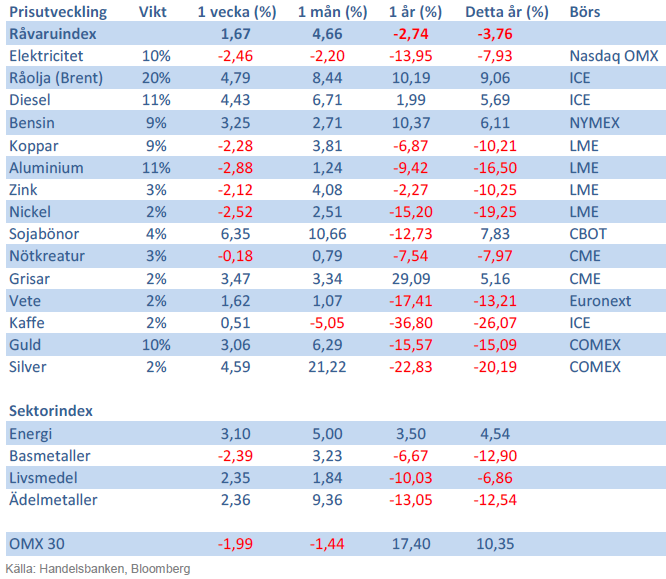
Handelsbankens råvaruindex består av de underliggande indexen för respektive råvara. Vikterna är bestämda till hälften från värdet av nordisk produktion (globala produktionen för sektorindex) och till hälften från likviditeten i terminskontrakten.
[box]SHB Råvarubrevet är producerat av Handelsbanken och publiceras i samarbete och med tillstånd på Råvarumarknaden.se[/box]
Ansvarsbegränsning
Detta material är producerat av Svenska Handelsbanken AB (publ) i fortsättningen kallad Handelsbanken. De som arbetar med innehållet är inte analytiker och materialet är inte oberoende investeringsanalys. Innehållet är uteslutande avsett för kunder i Sverige. Syftet är att ge en allmän information till Handelsbankens kunder och utgör inte ett personligt investeringsråd eller en personlig rekommendation. Informationen ska inte ensamt utgöra underlag för investeringsbeslut. Kunder bör inhämta råd från sina rådgivare och basera sina investeringsbeslut utifrån egen erfarenhet.
Informationen i materialet kan ändras och också avvika från de åsikter som uttrycks i oberoende investeringsanalyser från Handelsbanken. Informationen grundar sig på allmänt tillgänglig information och är hämtad från källor som bedöms som tillförlitliga, men riktigheten kan inte garanteras och informationen kan vara ofullständig eller nedkortad. Ingen del av förslaget får reproduceras eller distribueras till någon annan person utan att Handelsbanken dessförinnan lämnat sitt skriftliga medgivande. Handelsbanken ansvarar inte för att materialet används på ett sätt som strider mot förbudet mot vidarebefordran eller offentliggörs i strid med bankens regler.
Analys
The Mid-East anchor dragging crude oil lower

When it starts to move lower it moves rather quickly. Gaza, China, IEA. Brent crude is down 2.1% today to $62/b after having traded as high as $66.58/b last Thursday and above $70/b in late September. The sell-off follows the truce/peace in Gaze, a flareup in US-China trade and yet another bearish oil outlook from the IEA.

A lasting peace in Gaze could drive crude oil at sea to onshore stocks. A lasting peace in Gaza would probably calm down the Houthis and thus allow more normal shipments of crude oil to sail through the Suez Canal, the Red Sea and out through the Bab-el-Mandeb Strait. Crude oil at sea has risen from 48 mb in April to now 91 mb versus a pre-Covid normal of about 50-60 mb. The rise to 91 mb is probably the result of crude sailing around Africa to be shot to pieces by the Houthis. If sailings were to normalize through the Suez Canal, then it could free up some 40 mb in transit at sea moving onshore into stocks.
The US-China trade conflict is of course bearish for demand if it continues.
Bearish IEA yet again. Getting closer to 2026. Credibility rises. We expect OPEC to cut end of 2025. The bearish monthly report from the IEA is what it is, but the closer we get to 2026, the more likely the IEA is of being ball-park right in its outlook. In its monthly report today the IEA estimates that the need for crude oil from OPEC in 2026 will be 25.4 mb/d versus production by the group in September of 29.1 mb/d. The group thus needs to do some serious cutting at the end of 2025 if it wants to keep the market balanced and avoid inventories from skyrocketing. Given that IEA is correct that is. We do however expect OPEC to implement cuts to avoid a large increase in inventories in Q1-26. The group will probably revert to cuts either at its early December meeting when they discuss production for January or in early January when they discuss production for February. The oil price will likely head yet lower until the group reverts to cuts.
Dubai: The Mid-East anchor dragging crude oil lower. Surplus emerging in Mid-East pricing. Crude oil prices held surprisingly strong all through the summer. A sign and a key source of that strength came from the strength in the front-end backwardation of the Dubai crude oil curve. It held out strong from mid-June and all until late September with an average 1-3mth time-spread premium of $1.8/b from mid-June to end of September. The 1-3mth time-spreads for Brent and WTI however were in steady deterioration from late June while their flat prices probably were held up by the strength coming from the Persian Gulf. Then in late September the strength in the Dubai curve suddenly collapsed. Since the start of October it has been weaker than both the Brent and the WTI curves. The Dubai 1-3mth time-spread now only stands at $0.25/b. The Middle East is now exporting more as it is producing more and also consuming less following elevated summer crude burn for power (Aircon) etc.
The only bear-element missing is a sudden and solid rise in OECD stocks. The only thing that is missing for the bear-case everyone have been waiting for is a solid, visible rise in OECD stocks in general and US oil stocks specifically. So watch out for US API indications tomorrow and official US oil inventories on Thursday.
No sign of any kind of fire-sale of oil from Saudi Arabia yet. To what we can see, Saudi Arabia is not at all struggling to sell its oil. It only lowered its Official Selling Prices (OSPs) to Asia marginally for November. A surplus market + Saudi determination to sell its oil to the market would normally lead to a sharp lowering of Saudi OSPs to Asia. Not yet at least and not for November.
The 5yr contract close to fixed at $68/b. Of importance with respect to how far down oil can/will go. When the oil market moves into a surplus then the spot price starts to trade in a large discount to the 5yr contract. Typically $10-15/b below the 5yr contract on average in bear-years (2009, 2015, 2016, 2020). But the 5yr contract is usually pulled lower as well thus making this approach a moving target. But the 5yr contract price has now been rock solidly been pegged to $68/b since 2022. And in the 2022 bull-year (Brent spot average $99/b), the 5yr contract only went to $72/b on average. If we assume that the same goes for the downside and that 2026 is a bear-year then the 5yr goes to $64/b while the spot is trading at a $10-15/b discount to that. That would imply an average spot price next year of $49-54/b. But that is if OPEC doesn’t revert to cuts and instead keeps production flowing. We think OPEC(+) will trim/cut production as needed into 2026 to prevent a huge build-up in global oil stocks and a crash in prices. But for now we are still heading lower. Into the $50ies/b.
Analys
More weakness and lower price levels ahead, but the world won’t drown in oil in 2026

Some rebound but not much. Brent crude rebounded 1.5% yesterday to $65.47/b. This morning it is inching 0.2% up to $65.6/b. The lowest close last week was on Thursday at $64.11/b.

The curve structure is almost as week as it was before the weekend. The rebound we now have gotten post the message from OPEC+ over the weekend is to a large degree a rebound along the curve rather than much strengthening at the front-end of the curve. That part of the curve structure is almost as weak as it was last Thursday.
We are still on a weakening path. The message from OPEC+ over the weekend was we are still on a weakening path with rising supply from the group. It is just not as rapidly weakening as was feared ahead of the weekend when a quota hike of 500 kb/d/mth for November was discussed.
The Brent curve is on its way to full contango with Brent dipping into the $50ies/b. Thus the ongoing weakening we have had in the crude curve since the start of the year, and especially since early June, will continue until the Brent crude oil forward curve is in full contango along with visibly rising US and OECD oil inventories. The front-month Brent contract will then flip down towards the $60/b-line and below into the $50ies/b.
At what point will OPEC+ turn to cuts? The big question then becomes: When will OPEC+ turn around to make some cuts? At what (price) point will they choose to stabilize the market? Because for sure they will. Higher oil inventories, some more shedding of drilling rigs in US shale and Brent into the 50ies somewhere is probably where the group will step in.
There is nothing we have seen from the group so far which indicates that they will close their eyes, let the world drown in oil and the oil price crash to $40/b or below.
The message from OPEC+ is also about balance and stability. The world won’t drown in oil in 2026. The message from the group as far as we manage to interpret it is twofold: 1) Taking back market share which requires a lower price for non-OPEC+ to back off a bit, and 2) Oil market stability and balance. It is not just about 1. Thus fretting about how we are all going to drown in oil in 2026 is totally off the mark by just focusing on point 1.
When to buy cal 2026? Before Christmas when Brent hits $55/b and before OPEC+ holds its last meeting of the year which is likely to be in early December.
Brent crude oil prices have rebounded a bit along the forward curve. Not much strengthening in the structure of the curve. The front-end backwardation is not much stronger today than on its weakest level so far this year which was on Thursday last week.

The front-end backwardation fell to its weakest level so far this year on Thursday last week. A slight pickup yesterday and today, but still very close to the weakest year to date. More oil from OPEC+ in the coming months and softer demand and rising inventories. We are heading for yet softer levels.

Analys
A sharp weakening at the core of the oil market: The Dubai curve

Down to the lowest since early May. Brent crude has fallen sharply the latest four days. It closed at USD 64.11/b yesterday which is the lowest since early May. It is staging a 1.3% rebound this morning along with gains in both equities and industrial metals with an added touch of support from a softer USD on top.

What stands out the most to us this week is the collapse in the Dubai one to three months time-spread.
Dubai is medium sour crude. OPEC+ is in general medium sour crude production. Asian refineries are predominantly designed to process medium sour crude. So Dubai is the real measure of the balance between OPEC+ holding back or not versus Asian oil demand for consumption and stock building.
A sharp weakening of the front-end of the Dubai curve. The front-end of the Dubai crude curve has been holding out very solidly throughout this summer while the front-end of the Brent and WTI curves have been steadily softening. But the strength in the Dubai curve in our view was carrying the crude oil market in general. A source of strength in the crude oil market. The core of the strength.
The now finally sharp decline of the front-end of the Dubai crude curve is thus a strong shift. Weakness in the Dubai crude marker is weakness in the core of the oil market. The core which has helped to hold the oil market elevated.
Facts supports the weakening. Add in facts of Iraq lifting production from Kurdistan through Turkey. Saudi Arabia lifting production to 10 mb/d in September (normal production level) and lifting exports as well as domestic demand for oil for power for air con is fading along with summer heat. Add also in counter seasonal rise in US crude and product stocks last week. US oil stocks usually decline by 1.3 mb/week this time of year. Last week they instead rose 6.4 mb/week (+7.2 mb if including SPR). Total US commercial oil stocks are now only 2.1 mb below the 2015-19 seasonal average. US oil stocks normally decline from now to Christmas. If they instead continue to rise, then it will be strongly counter seasonal rise and will create a very strong bearish pressure on oil prices.
Will OPEC+ lift its voluntary quotas by zero, 137 kb/d, 500 kb/d or 1.5 mb/d? On Sunday of course OPEC+ will decide on how much to unwind of the remaining 1.5 mb/d of voluntary quotas for November. Will it be 137 kb/d yet again as for October? Will it be 500 kb/d as was talked about earlier this week? Or will it be a full unwind in one go of 1.5 mb/d? We think most likely now it will be at least 500 kb/d and possibly a full unwind. We discussed this in a not earlier this week: ”500 kb/d of voluntary quotas in October. But a full unwind of 1.5 mb/d”
The strength in the front-end of the Dubai curve held out through summer while Brent and WTI curve structures weakened steadily. That core strength helped to keep flat crude oil prices elevated close to the 70-line. Now also the Dubai curve has given in.

Brent crude oil forward curves

Total US commercial stocks now close to normal. Counter seasonal rise last week. Rest of year?

Total US crude and product stocks on a steady trend higher.

-

 Nyheter4 veckor sedan
Nyheter4 veckor sedanTyskland har så höga elpriser att företag inte har råd att använda elektricitet
-

 Nyheter3 veckor sedan
Nyheter3 veckor sedanOPEC+ missar produktionsmål, stöder oljepriserna
-

 Nyheter3 veckor sedan
Nyheter3 veckor sedanEtt samtal om guld, olja, fjärrvärme och förnybar energi
-

 Analys4 veckor sedan
Analys4 veckor sedanBrent crude ticks higher on tension, but market structure stays soft
-

 Nyheter2 veckor sedan
Nyheter2 veckor sedanGuld nära 4000 USD och silver 50 USD, därför kan de fortsätta stiga
-

 Analys3 veckor sedan
Analys3 veckor sedanAre Ukraine’s attacks on Russian energy infrastructure working?
-

 Nyheter1 vecka sedan
Nyheter1 vecka sedanGoldman Sachs höjer prognosen för guld, tror priset når 4900 USD
-

 Nyheter3 veckor sedan
Nyheter3 veckor sedanGuldpriset uppe på nya höjder, nu 3750 USD


